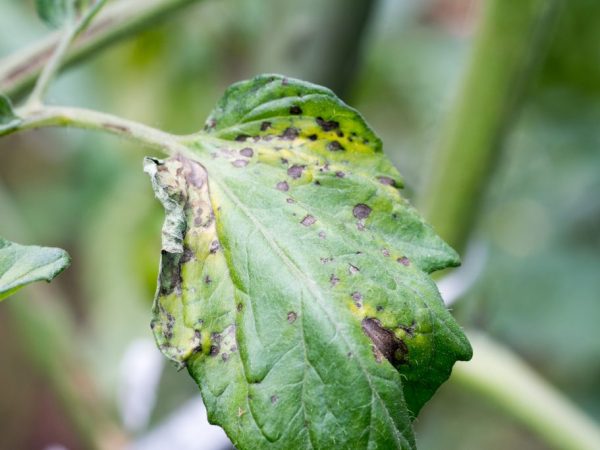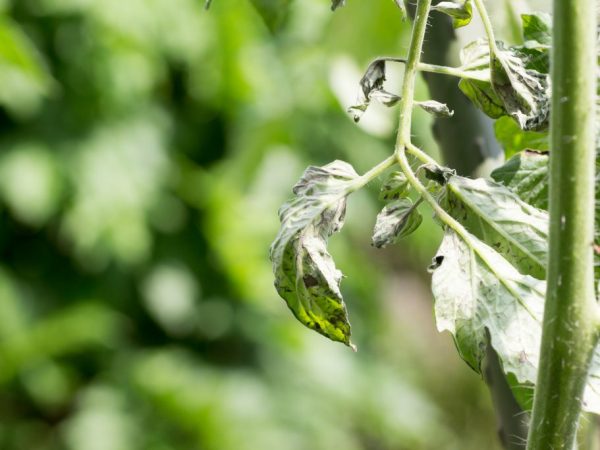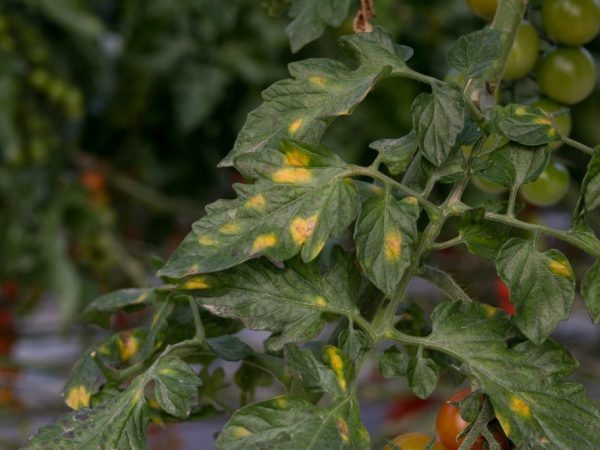Why spots appear on the leaves of tomatoes
Spots on the leaves of tomatoes are a serious problem that must be addressed immediately so as not to lose crops. The cause can be diseases caused by fungi, bacteria and even viruses. Sometimes this phenomenon is associated with a lack or excess of minerals in the soil. Consider the diseases of tomatoes, manifested by spots, as well as prevention and control measures.

Spots on the leaves of tomatoes
Reasons for the appearance
What are the spots on tomato leaves? They can be very small, resemble dots, or cover the entire sheet. Most often, such formations lead to thinning and drying of the foliage. The spots are dense, moist, resembling rot. The dots can be white, black, brown, gray, yellow in color. Sometimes the leaves become multi-colored.
The main reasons for the formation of spots on tomato leaves:
- bacterial diseases;
- fungal diseases;
- viral lesions;
- lack or excess of iron, nitrogen and other minerals.
Most often, the problem arises if the tomatoes are taken care of incorrectly or if they grow in the wrong place. Sometimes epidemics of infectious diseases affect an entire region. Often, infections are transmitted with the seed, so the seeds should be selected carefully.
Many pathologies are transmitted to tomatoes from potatoes, eggplants, therefore, these crops cannot be planted nearby.
Bacterial diseases
Tomato black spot is caused by microorganisms of the genus Xanthamonas. In total, 4 phenotypes of these pathogens are known. They can persist in the seed throughout the winter. In the southern regions, they live until spring in the tops of plants. They do not live long in the ground without the main source of food (tomato waste). Infection most often occurs through inoculum.
When a disease occurs on the leaves, olive dots of an oily consistency first appear, then they darken in the center, a light rim forms along the outer contour. The size of the dots is 5-6 mm. Stems and fruits can also be affected. The plant loses 50% to 100% of its foliage and dries up. Black spot progresses at an air temperature of 25-30 ° C and humidity above 70%. If left unchecked, it quickly ruins the entire landing.
Ways to fight
To combat bacteria, seeds are recommended to be treated with a number of agents:
- sodium hydrochloride 3-5%;
- calcium hydrochloride 6-8%;
- trisodium phosphate (12 g per 100 ml of water).
Seeds should be soaked in hydrochlorides for 10-30 minutes, in trisodium phosphate for an hour.
Seedlings and adult tomatoes are treated with Fitolavin, Acrobat, Hom, Bordeaux liquid. It is very important to burn off any leftover contaminated tomatoes. Black bacterial spot is transmitted from tomatoes to eggplants, potatoes, peppers, therefore nightshade crops cannot be planted in this area for 3-4 years.
Fungal diseases

Excess moisture can cause fungal diseases.
These diseases are caused by fungi and are one of the most common causes of color stains and crop failure. The lesion begins with the stems and is practically not noticeable in the first days. The fungus quickly spreads throughout the plant, affecting leaves and fruits. Tomatoes die after 5-10 days. Greenhouse tomatoes are most often affected, but the bushes can also hurt in open beds, especially in hot, humid summers. Too abundant watering, an excess of nitrogen in the soil often becomes a provoking factor.
Gray rot
The gray rot is caused by the fungus Botrytis cinerea Pers. It affects agricultural crops with high humidity, excess nitrogenous fertilizers in the soil. With this type of disease, gray spots appear on tomatoes. On the fruits, you can see a characteristic fluffy bloom of a white-gray hue, rotten areas. The stem of the tomatoes is also affected. The disease is quickly transmitted from one plant to another, in a few days it can destroy an entire garden bed, if measures are not taken in time to destroy the fungus.
Ways to fight
To get rid of gray mold, fungicides should be used. Acrobat MC, Profit Gold, Abiga-Peak, Previkur work well on the fungus. For the prevention of diseases, tomatoes can be treated with Bordeaux mixture, copper sulfate, garlic infusion.
It is important to regularly ventilate the greenhouse, try to prevent water from falling on the leaves when watering.
White rot
The disease is caused by the fungus Sclerotinia sclerotiorum. It develops best in high humidity and low temperatures (about 18 ° C). First, signs of damage appear on the fruits. They soften, crack, become covered with white dots. Then the stain from the tomato fruit passes to other parts of the plant. It can be seen that the leaves became almost transparent, covered with white dots and specks, and began to dry out.
Ways to fight
It is very difficult to treat white rot, the best solution is to destroy the plants. To prevent the disease, before sowing seeds, the soil is fried in the oven, treated with a weak solution of potassium permanganate. Before planting seedlings, the land in the greenhouse is watered with copper sulfate (2 g / 10 l of water), urea (10 g / 10 l of water), zinc sulfate (1 g / 10 l of water). It is important to maintain normal temperature and humidity in the greenhouse.
Brown rot
The disease is caused by the fungus Phoma destructiva, which is often transferred to the bushes along with fresh manure. The second name of the disease is phomosis. On the leaves of tomatoes, brown or almost black small spots can be seen, gradually increasing in size, darkening, becoming black. On the stems, they are arranged in concentric circles. Brown spots on ripe tomatoes first appear near the stalk and then affect the entire fruit.
Ways to fight
Brown rot is not cured, the plants should be destroyed and the soil disinfected. For prevention, it is advised to control humidity, do not use fresh manure for fertilization, and reduce the amount of fertilizing containing nitrogen.
Late blight

Infected bushes should be removed
The disease is caused by the late blight fungus, which often parasitizes on potatoes, eggplants, peppers, and from these crops passes to tomatoes. Brown dark spots first appear on the underside of the leaves, then on the stems and fruits. The foliage dries up and falls off, flowers and young ovaries crumble.
Ways to fight
To combat late blight, ready-made fungicides are used (Previkur, Findazol, Horus, Hom, Topaz, etc.). Treatment with Bordeaux liquid and copper sulfate (2 tbsp. L / 10 l of water) helps well. You can take the antibiotic Trichopolum for treatment (10 tablets / 10 l of water), a tincture of garlic, mixed with a weak solution of potassium permanganate, works well. After harvesting, the tops are destroyed and the soil is disinfected. It is forbidden to plant tomatoes, potatoes, peppers and eggplants in this place for another 3-4 years.
Brown spot
Brown spot, or cladosporia, is more likely to appear on tomatoes that grow in a greenhouse. Outdoors, the fungus can infect tomatoes that are watered too much. Plants get sick on hot summer days in shaded beds with poor ventilation. Gray-brown or olive spots with a fluffy bloom appear on the lower part of the leaves. There are yellow spots on top. Gradually, the foliage dries up and falls off. Large ripe fruits are rarely affected, but the ovaries and flowers fall off, and the yield falls. It happens that several bushes are affected in the garden, and most of the plants remain healthy.
Ways to fight
At the first sign of cladosporia, diseased leaves are cut off. The bushes are treated with a 1% solution of Bordeaux liquid, Hom antifungal agents (40 g of the drug per 10 l of water) and Effekton-O. Tincture of garlic, copper sulfate (50 g / 10 l of water) work well on fungi. For prevention, watering should be properly regulated, the optimal amount of fertilizer should be applied. The greenhouse is regularly ventilated and the temperature does not rise too high.
Goblet rust
Goblet rust is another fungal disease of tomatoes. It is virtually untreatable. At first, small yellow dots are visible on the foliage, which gradually increase. Plants gradually deform, stop bearing fruit and dry out. If rusty or yellowish spots appear on the leaves of tomatoes in the greenhouse, the entire crop dies very quickly.
Ways to fight
To prevent goblet rust, tomatoes are regularly treated with fungicides. Copper sulfate, 1% Bordeaux liquid, Oxyhom, Figon, Fundazol preparations are used. Folk remedies help well: soda ash, infusion of marigolds or horsetail. To prevent fungus from growing in the greenhouse, it needs to be regularly ventilated, watering should be regulated. Before planting tomatoes, it is advisable to disinfect the greenhouse and the soil.
Alternaria or macrosporiosis

The infected plant can quickly die.
Another name for the disease is dry spotting, brown spotting, macrosporosis. It is caused by the fungus Alternaria (Macrosporium). Most often, bushes growing in a greenhouse suffer. The disease spreads rapidly in hot summers, when the average daily air temperature reaches 25-30 ° C. The fungus enters the soil and tomatoes from infected seeds, manure, and then quickly spreads to the stem and foliage.
Signs
The first signs appear immediately after planting seedlings in open ground. Almost all parts of the bush are affected. On tomato leaves, spots of yellow-brown color appear, round and dry. Their size ranges from a few millimeters to a centimeter. On the stems, the spots are gray-brown. Even in rainy weather, the affected areas remain dry, which distinguishes mycosporosis from late blight. The stain from the stems of the tomato passes to the fruit. Affected plants wither and dry quickly.
Ways to fight
When the first signs of dry brown spot appear on tomatoes, the bushes are treated with fungicides. It is best to use drugs Ditan-M45, Antrakol 70, Infinity, Quadris, Flint. Plants are treated 3-4 times per season with a break of 10-14 days.
Prophylaxis
For the prevention of a fungal disease, it is necessary:
- Choose seeds carefully, buy them only from trusted sellers.
- Process the seeds before planting with potassium permanganate.
- Disinfect the soil for growing seedlings and adult tomatoes.
- Observe the rules of crop rotation, do not plant tomatoes after potatoes, peppers, eggplants, cabbage, in the same place the culture can be planted no more than once every 3 years.
- Correctly dose watering, the amount of nitrogen fertilizers.
- After picking tomatoes, the tops should be burned.
If you adhere to all the rules, tomatoes will not be threatened by any fungal disease.
Viral diseases
Spots on tomatoes can appear due to viral lesions.It is almost impossible to fight these pathogens. One of the most effective preventive measures is the cultivation of resistant varieties. Most often, tomatoes affect the following viral diseases:
- mosaic;
- tomato streak.
Mosaic
Tomato mosaic is caused by several types of viruses. In most cases, the cause is Tomato mosaic tobamovirus (tobacco mosaic virus). The disease is manifested by mottled leaves: some areas become light, others - dark. The spotted leaves are deformed, curled, the fruits become small, the yield drops by almost half. With enation mosaic, specific outgrowths (enations) appear on the lower part of the leaves, fruit necrosis is observed.
Ways to fight
With the initial manifestations of a viral lesion, the bushes can be treated with 10% milk serum, inversely, with the addition of a 0.05% solution of the Pharmayod-3 preparation. The remains of diseased plants are disinfected with trisodium phosphate, and then burned. The same solution is used to disinfect the soil in a greenhouse or in a garden bed.
In the future, it is advisable to choose varieties that are resistant to mosaic (Semko, Zhenaros, Madison, Anyuta, Sors, Kunero).
Tomato streak
This disease is caused by several viruses at once (tomato mosaic virus, potato X-virus, cucumber mosaic virus). Light streaks appear on the leaves, trunk and fruits of tomatoes, areas of necrosis with a rough surface. Gradually they merge, the stems and foliage dry up, and the fruits crack. Bushes die, and the entire crop is lost.
Ways to fight
Treating a tomato streak is almost impossible. Diseased tomatoes are best destroyed immediately.
It is also important to weed out all the weeds in the garden bed and in the aisles: they can be infected with the virus. It is very important to destroy aphids: they carry pathogens. Seeds for planting should be taken only from trusted suppliers. The seedling soil can be disinfected with potassium permanganate or roasted in the oven. All tools that are used for picking tomatoes, pinning must be clean and disinfected.


